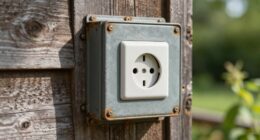To keep food safe at buffets and outdoor events, monitor temperatures regularly—hot foods should stay above 140°F, and cold foods below 40°F using reliable thermometers. Keep raw and cooked foods separate, label everything clearly, and use different utensils to prevent cross-contamination. Maintain proper hygiene, cover foods when not served, and ensure proper setup with chilled or heated displays. Following these tips helps prevent illness; more strategies await if you continue exploring.
Key Takeaways
- Keep hot foods at ≥140°F and cold foods at ≤40°F using proper equipment and temperature monitoring.
- Use separate utensils and clearly label all foods, especially allergens, to prevent cross-contamination.
- Regularly sanitize surfaces, utensils, and hands to maintain hygiene standards during setup and service.
- Cover foods when not served, and replace items that have been out too long to prevent bacterial growth.
- Maintain appropriate outdoor equipment to keep foods at safe temperatures and protect against insects and debris.
Managing Temperature Control for Safe Food
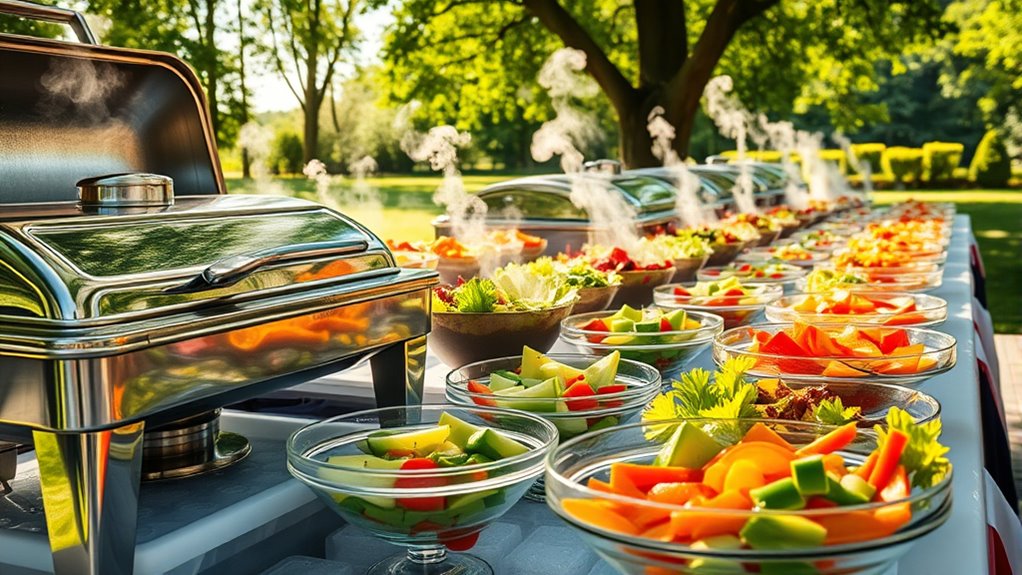
Proper temperature control is essential to prevent foodborne illnesses. You should regularly monitor temperatures to ensure food stays within safe ranges. Use a reliable thermometer to check hot foods, keeping them at 140°F or higher through hot holding. For cold foods, maintain temperatures at 40°F or lower with cold holding methods. Consistent temperature monitoring helps you catch any deviations early, preventing bacteria growth. Keep hot foods hot by using chafing dishes or warming trays, and chill cold foods promptly. Avoid leaving perishable items at unsafe temperatures for too long. Sizing and load‑planning tools can help you determine the appropriate equipment to maintain safe temperatures effectively. By actively managing hot and cold holding temperatures, you create a safer environment for your guests and reduce the risk of foodborne illnesses. Proper temperature control is a key step in effective food safety.
Preventing Cross-Contamination at Your Event
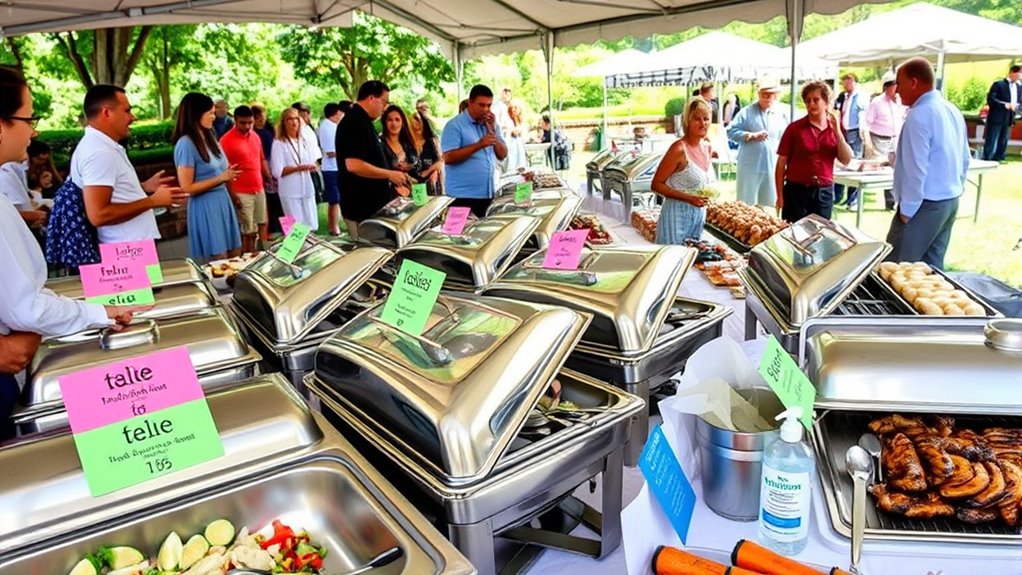
To prevent cross-contamination at your event, you need to implement careful handling and separation of different food items. Start by clearly labeling foods, especially those containing common allergens, to guarantee guests and staff recognize potential risks. Use separate utensils and serving tools for each dish to avoid transferring bacteria or allergens between items. Designate specific areas for raw and cooked foods to prevent cross-contact. Regularly sanitize surfaces and utensils, and encourage staff to wash hands frequently. Proper allergen management is vital; keep allergen-containing foods apart and labeled distinctly. This reduces accidental exposure for guests with food allergies and helps maintain food safety standards. Implementing hygiene best practices further minimizes contamination risks and fosters a safer environment for everyone. Being vigilant about labeling and separation minimizes cross-contamination risks, creating a safer environment for everyone.
Proper Food Handling and Hygiene Practices
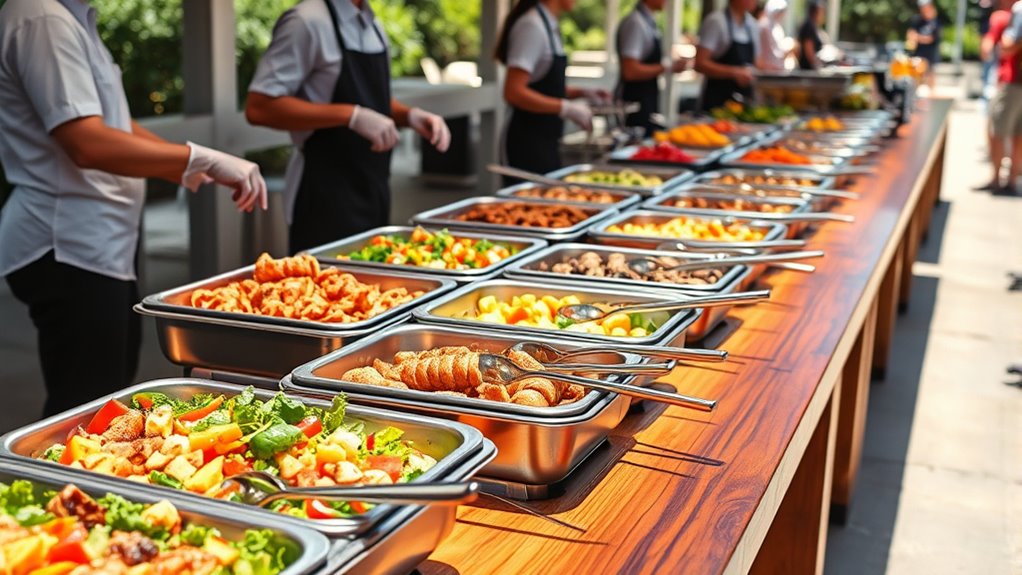
Maintaining good food handling and hygiene practices is essential to prevent foodborne illnesses and guarantee safety during your event. Proper food handling involves washing hands frequently, using clean utensils, and avoiding cross-contact between raw and cooked foods. Hygiene practices also include wearing gloves, tying back hair, and sanitizing surfaces regularly. To emphasize the importance, consider this table:
| Food Handling | Hygiene Practices | Key Outcomes |
|---|---|---|
| Wash hands before handling food | Use gloves when necessary | Minimize contamination risks |
| Keep raw and cooked separate | Clean surfaces often | Ensure food safety |
| Store at correct temperatures | Cover foods properly | Maintain freshness and safety |
Additionally, adhering to proper beach safety guidelines can help prevent accidents and ensure a safe and enjoyable experience for all attendees.
Safe Setup and Maintenance of Buffets

Setting up and maintaining a buffet safely is essential to prevent foodborne illnesses and guarantee a pleasant experience for your guests. Focus on proper buffet presentation by arranging foods neatly and ensuring hot foods stay hot and cold foods stay cold. Use appropriate equipment, like chafing dishes and ice baths, to maintain safe temperatures. Keep the area clean and organized, regularly checking for spills or debris. Clear signage and labeling are critical; label foods accurately to prevent allergic reactions and cross-contamination. Place labels where guests can easily see them, including ingredients and potential allergens. Refresh food as needed and remove items that have been out too long. Consistent maintenance and clear signage help guarantee your buffet remains safe and appealing throughout your event.
Best Practices for Outdoor Food Safety
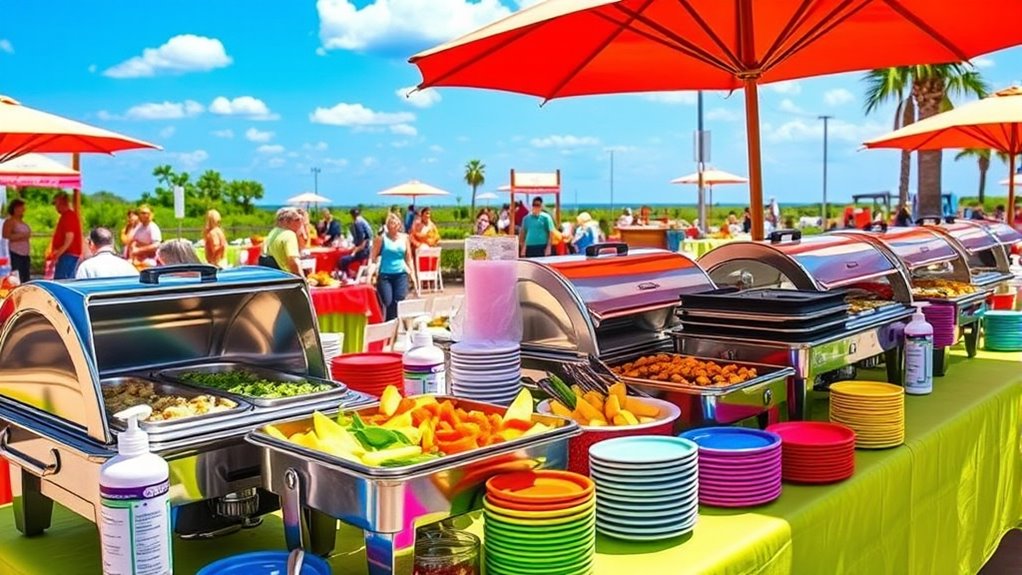
When hosting a buffet outdoors, assuring food safety requires extra attention to environmental factors. You should keep hot foods hot and cold foods cold, using appropriate equipment like chafing dishes and coolers. Proper food labeling is essential, especially to clearly identify dishes and note allergen information, so guests can make safe choices. Be vigilant about allergen awareness; know which ingredients may trigger reactions and communicate this clearly through labels. Regularly monitor temperatures and replace perishable items promptly to prevent bacterial growth. Cover foods when not being served to protect against insects and contaminants. Maintain hygiene by providing handwashing stations or hand sanitizer nearby. Additionally, keep track of Hours Today List for relevant store timings to ensure supplies are available when needed. These best practices help prevent foodborne illnesses and ensure a safe, enjoyable outdoor dining experience for everyone.
Frequently Asked Questions
How Can I Ensure Food Safety During Unexpected Power Outages?
During a power outage, you should quickly switch to power outage preparedness by keeping emergency food storage stocked with non-perishable items. Keep perishable foods cold using coolers with ice packs, and avoid opening refrigerator or freezer doors frequently. Use a food thermometer to monitor temperatures, ensuring cold foods stay below 40°F. Acting swiftly helps prevent bacterial growth and keeps food safe until power is restored.
What Are Effective Methods to Keep Insects Away From Outdoor Food Stations?
To keep insects away from outdoor food stations, you should use effective insect deterrents like citronella candles or insect-repellent sprays around your setup. Cover food with tight-fitting lids and use food protection techniques such as serving dishes with covers or food tents. Keep the area clean and dispose of waste promptly, as it attracts bugs. Regularly monitor the site to ensure these measures stay effective throughout your event.
How Should Leftover Buffet Items Be Safely Stored and Reused?
Like the wise who conserve resources, you should promptly store leftover buffet items in airtight containers and keep them refrigerated at 40°F or below. Follow proper storage practices and adhere to reuse guidelines, such as consuming leftovers within three to four days. Always reheat leftovers thoroughly to 165°F before serving again. This approach helps prevent foodborne illness and guarantees leftovers remain safe and delicious for future enjoyment.
What Are the Legal Requirements for Food Safety at Large Outdoor Events?
At large outdoor events, you must adhere to legal requirements by guaranteeing food inspection and sanitation standards are met. You should regularly monitor food temperatures, keep raw and cooked foods separate, and maintain proper sanitation practices. Make certain all vendors have valid permits and follow local health regulations. By doing so, you protect attendees and avoid legal issues, demonstrating your commitment to food safety and compliance with health authorities.
How Do Weather Conditions Impact Food Safety Protocols at Outdoor Venues?
Weather conditions profoundly impact your food safety protocols at outdoor venues. High humidity control helps prevent bacterial growth, so keep foods at proper temperatures and cover them to reduce moisture. Sunlight exposure can promote spoilage, so use shaded areas or protective covers to shield food from direct sunlight. Monitoring weather forecasts allows you to adjust your safety measures accordingly, ensuring your food stays safe regardless of changing outdoor conditions.
Conclusion
Now that you know the key steps to guarantee food safety at buffets and outdoor events, imagine the scene: guests happily enjoying their meals, unaware of the careful precautions you’ve taken. But what if one detail slips through? The difference between a memorable celebration and a food safety disaster is in your hands. Stay vigilant, follow these practices, and keep your event safe—because the next moment could be the one everyone remembers for all the right reasons.








